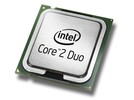Intel Core 2 Duo P9500 vs Intel Core 2 Duo T9600
Intel Core 2 Duo P9500
► remove from comparison
Der Intel Core 2 Duo P9500 ist ein sparsamer Doppelkernprozessor für Notebooks der oberen Mittelklasse. Er gehört zur Penryn Serie und wird in 45nm gefertigt. Der Prozessor wurde später vom 2.63 GHz schnellen P9600 zum selben Startpreis abgelöst, welcher ebenfalls nur 25 Watt braucht.
Die Performance des Core 2 Duo P9500 ist vergleichbar mit dem ebenfalls mit 2.53 GHz getakteten Core 2 Duo T9400 und dadurch sollte sie für die meisten Spiele in 2009 ausreichen (nur GTA 4 profitiert deutlich von mehr Prozessorkernen oder höherem Takt). Der alte Core 2 Quad Q9000 wird auch bei den meisten Anwendungen geschlagen, da er mit nur 2.0 GHz getaktet wird.
Der Penryn (Montevina Update) Kern bietet 2 Integer Units, 1 Floating Point Unit, 1 Load Unit und 1 Store Unit in einer 14-stufigen Pipeline. Mit der Wide Dynamic Execution Technologie kann der Kern bis zu vier volle Instruktionen gleichzeitig ausführen.
Intel Core 2 Duo T9600
► remove from comparison
Die Intel Core 2 Duo T9600 Dual-Core CPU ist ein High-End Dual-Core Prozessor für Notebooks. Die Architektur des Prozessors basiert auf den Penryn Kern und wird in 45nm gefertigt. Im Vergleich zum schnelleren T9900 unterstützt er jedoch noch nicht den C1E State. Der neuere Core 2 Duo P9700 bietet die selben Leistungsdaten, jedoch bei deutlich geringerem Stromverbrauch (28 W versus 35 Watt TDP).
Dank der relativ hohen Taktung von 2.8 GHz, ist die Performance für die alle Spiele in 2009 ausreichend (nur GTA 4 profitiert deutlich von mehr Prozessorkernen). Die alten Core 2 Quad Mobilprozessoren (Q9000, QX9300) werden dank der hohen Taktung bei den meisten Spielen geschlagen (da Spiele aus 2009 meist nicht mehr als 2 Kerne auslasten).
Der Penryn (Montevina Update) Kern bietet 2 Integer Units, 1 Floating Point Unit, 1 Load Unit und 1 Store Unit in einer 14-stufigen Pipeline. Mit der Wide Dynamic Execution Technologie kann der Kern bis zu vier volle Instruktionen gleichzeitig ausführen.
Dank Dynamic Acceleration (später Turbo Modus genannt), kann sich ein Kern um eine Stufe übertakten, wenn der zweite im Idle Modus (Leerlauf) ist.
Das integrierte Enhanced Speedstep kann die Taktfrequenz des Prozessors dynamisch an die Leistungsanforderungen anpassen. Dadurch läuft die CPU ohne Last nur mit 800 MHz.
Der Core 2 Duo T9900 passt in den Socket P (mit 479 Pins):
Socket P / Micro Flip-Chip Pin Grid Array (Micro-FCPGA) requires 479-pin surface mount Zero Insertion Force (ZIF) socket (mPGA479M socket) or Micro Flip-Chip Ball Grid Array (Micro-FCBGA) for surface mount (479-ball)
| Model | Intel Core 2 Duo P9500 | Intel Core 2 Duo T9600 |
| Series | Intel Core 2 Duo | Intel Core 2 Duo |
| Codename | Penryn | Penryn |
| Serie: Core 2 Duo Penryn | ||
| Clock | 2530 MHz | 2800 MHz |
| FSB | 1066 | 1066 |
| L1 Cache | 128 KB | |
| L2 Cache | 6 MB | 6 MB |
| Cores / Threads | 2 / 2 | 2 / 2 |
| TDP | 25 Watt | 35 Watt |
| Transistors | 410 Million | 410 Million |
| 45 nm | 45 nm, 1.05-1.2125 V | |
| Die Size | 107 mm2 | 107 mm2 |
| max. Temp. | 105 °C | 105 °C |
| Socket | BGA479, PGA478 | Socket P (BGA479, PGA478) |
| Features | Virtualization Technology (VT-x), Trusted Execution, Intel 64, Enhanced Speedstep, Execute Disable Bit | |
| Architecture | x86 | x86 |
| $348 U.S. | $316 U.S. | |
| Announced | ||
| Manufacturer | ark.intel.com | ark.intel.com |


 Deutsch
Deutsch English
English Español
Español Français
Français Italiano
Italiano Nederlands
Nederlands Polski
Polski Português
Português Русский
Русский Türkçe
Türkçe Svenska
Svenska Chinese
Chinese Magyar
Magyar